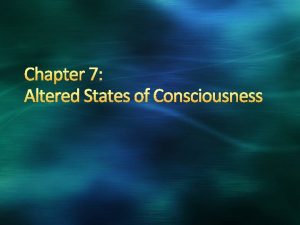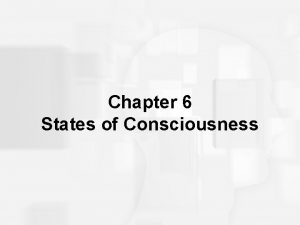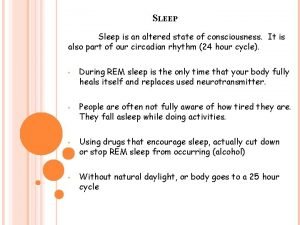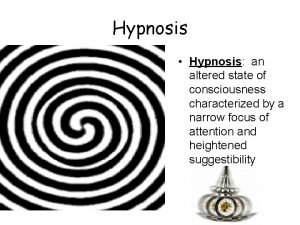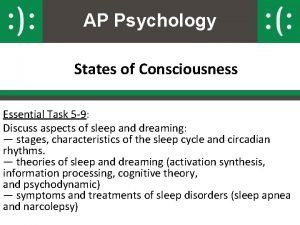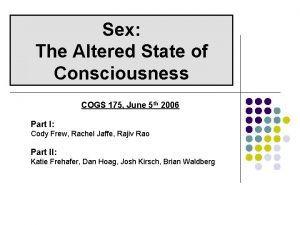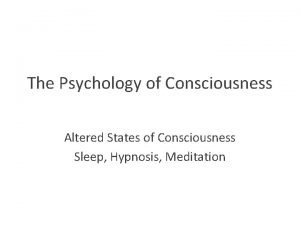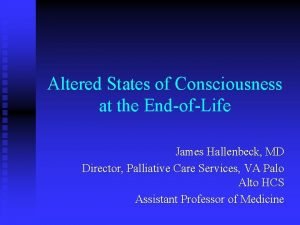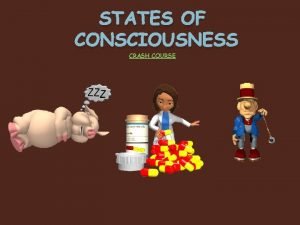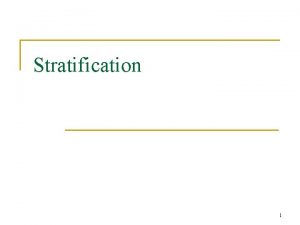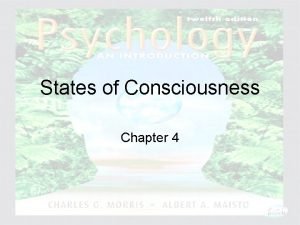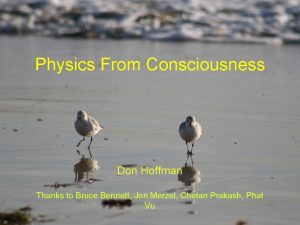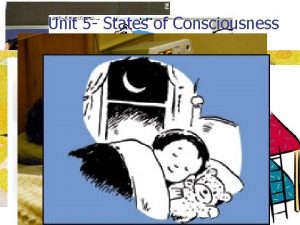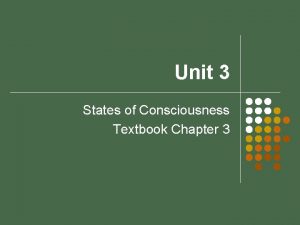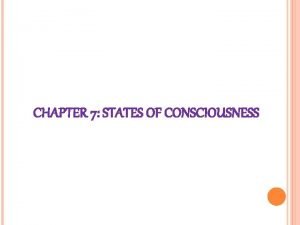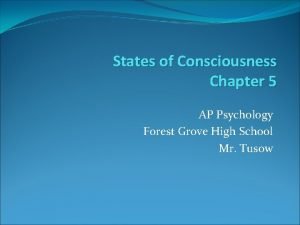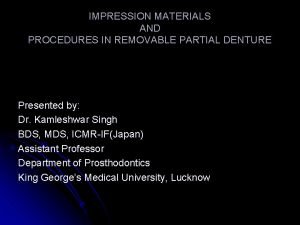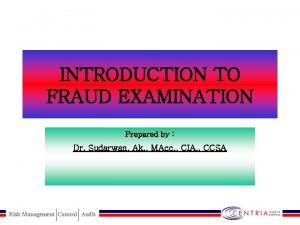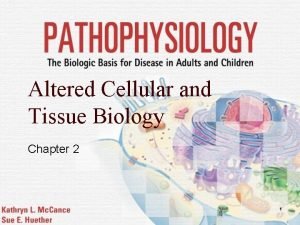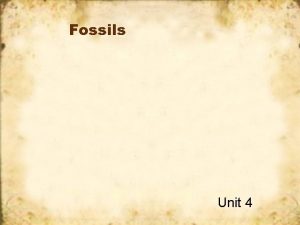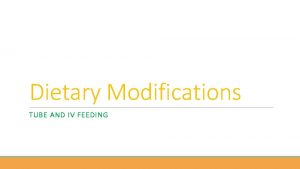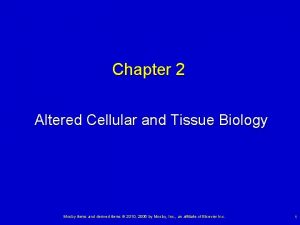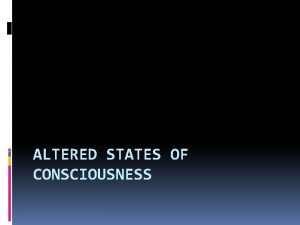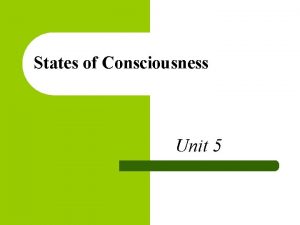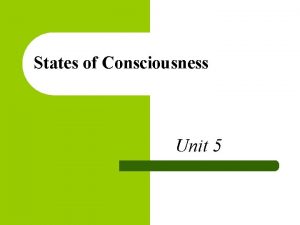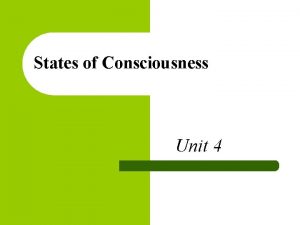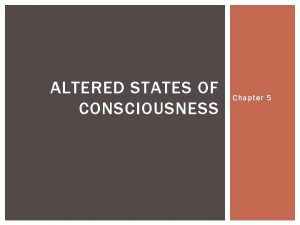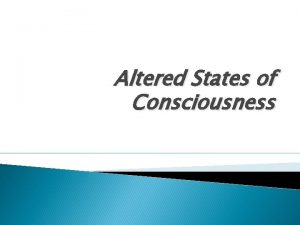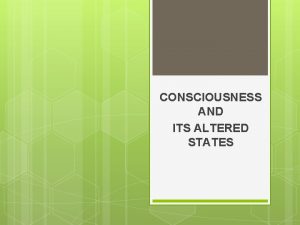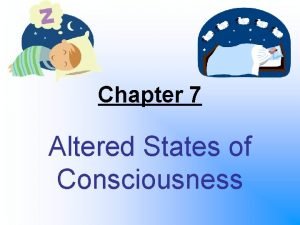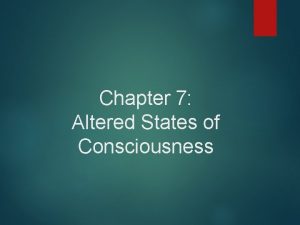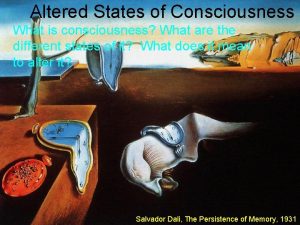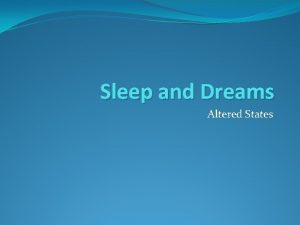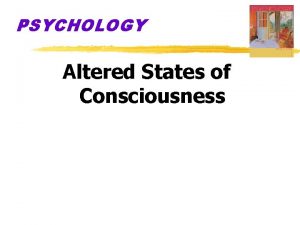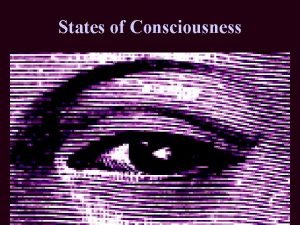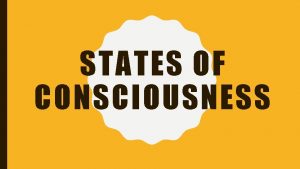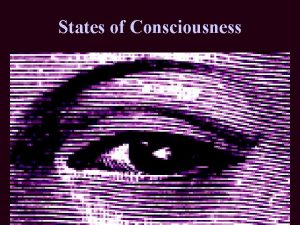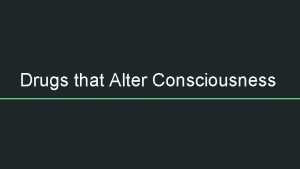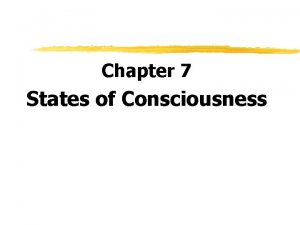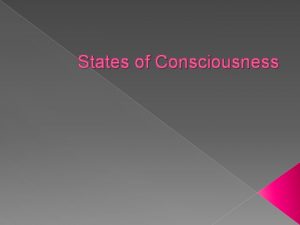Altered States of Consciousness A C S Consciousness

































- Slides: 33

Altered States of Consciousness • A. C. S • Consciousness that exists in forms other than your normal waking state – Sleeping/dreaming – Hypnosis – Meditation – Drugs

The Sleeping Mind

Sleep Stages • There are 5 identified stages of sleep. • It takes about 90 -100 minutes to pass through the 5 stages. • The brain’s waves will change according to the sleep stage you are in. • The first four sages and know as NREM sleep. . • The fifth stage is called REM sleep.

Stage One • This is experienced as falling to sleep and is a transition stage between wake and sleep. • It usually lasts between 1 and 5 minutes and occupies approximately 2 -5 % of a normal night of sleep. • Eyes begin to roll slightly. • Hallucinations can occur and feeling of falling.

Stage Two • This follows Stage 1 sleep and is the "baseline" of sleep. • This stage is part of the 90 minute cycle and occupies approximately 45 -60% of sleep. • Minor noises probably wont disturb you

Stage Three & Four • Stages three and four are "Delta" sleep or "slow wave" sleep and may last 15 -30 minutes. • It is called "slow wave" sleep because brain activity slows down dramatically from the "theta" rhythm of Stage 2 to a much slower rhythm called "delta" and the height or amplitude of the waves increases dramatically.

Stage Three and Four (continued) • Contrary to popular belief, it is delta sleep that is the "deepest" stage of sleep (not REM) and the most restorative. • It is delta sleep that a sleep-deprived person's brain craves the first and foremost. • In children, delta sleep can occupy up to 40% of all sleep time and this is what makes children unawake able or "dead asleep" during most of the night.

Stage Five: REM SLEEP • REM: Rapid Eye Movement • This is a very active stage of sleep. • Composes 20 -25 % of a normal nights sleep. • Breathing, heart rate and brain wave activity quicken. • Vivid Dreams can occur. • From REM, you go back to Stage 2

REM • Body is essentially paralyzed during REM. • Genitals become aroused. Erections and clitoral engorgement. • “Morning Erections” are from final REM stage. A typical 25 year old man has an erection during half of his sleep. A 65 year old- one quarter.


How much sleep do we need? • We all need different amounts of sleep depending on our age and genetics. • But we ALL sleep- about 25 years on average. How do you feel when you don’t get enough sleep?


Can you just make up lost sleep in one night? NO

Why do we need sleep? (Two theories) 1. Ecological Niche: back in the day, darkness meant death, those that slept did not go out, thus did not die. Sleep protects us.

2. Sleep helps us recuperate and restores the breakdown of our body.

Sleep Disorders

Insomnia • Recurring problems in falling or staying asleep. • Not your once in a while (I have a big test tomorrow) having trouble getting to sleep episodes. • Insomnia is not defined by the number of hours you sleep every night. • Primary versus Secondary insomnia. 60 Million

Narcolepsy • Characterized by uncontrollable sleep attacks. • Lapses directly into REM sleep (usually during times of stress or joy).

Sleep Apnea • A sleep disorder characterized by temporary cessations of breathing during sleep and consequent momentary reawakenings.

Night Terrors • A sleep disorder characterized by high arousal and an appearance of being terrified. • Occur in Stage 4, not REM, and are not often remembered.

Sleepwalking (Somnambulism) • Sleepwalking is a sleep disorder effecting an estimated 10 percent of all humans at least once in their lives. • Sleep walking most often occurs during deep non-REM sleep (stage 3 or stage 4 sleep) early in the night.

Sleepwalking Symptoms and Features: • Ambulation (walking or moving about) that occurs during sleep. The onset typically occurs in pre-pubertal children. • difficulty in arousing the patient during an episode • amnesia following an episode • Fatigue • stress and anxiety

Sleepwalking • The sleep walking activity may include simply sitting up and appearing awake while actually asleep, getting up and walking around, or complex activities such as moving furniture, going to the bathroom, dressing and undressing, and similar activities. Some people even drive a car while actually asleep. The episode can be very brief (a few seconds or minutes) or can last for 30 minutes or longer. • One common misconception is that a sleep walker should not be awakened. It is not dangerous to awaken a sleep walker, although it is common for the person to be confused or disoriented for a short time on awakening. Another misconception is that a person cannot be injured when sleep walking. Actually, injuries caused by such things as tripping and loss of balance are common for sleep walkers.


When we discovered the different stages of sleep, our dream research really took off!!! WHY? REM

Dreams • A sequence of images, emotions, and thoughts passing through a sleeping person’s mind. Manifest Content: the remembered storyline of a dream. Latent Content: the underlying meaning of a dream.

Manifest Content

Latent Content Dream Interpretation

Why do we Dream? Three Theories

Freud’s wish-fulfillment Theory • Dreams are the key to understanding our inner conflicts. • Ideas and thoughts that are hidden in our unconscious. • Manifest and latent content

Information-Processing Theory • Dreams act to sort out and understand the memories that you experience that day. • REM sleep does increase after stressful events.

Physiological Function Theories Activation-Synthesis Theory: • during the night our brainstem releases random neural activity, dreams may be a way to make sense of that activity.

REM Rebound • The tendency for REM sleep to increase following REM sleep deprivation. • What will happen if you don’t get a good nights sleep for a week, and then sleep for 10 hours? You will dream a lot.
 Consciousness def
Consciousness def Chapter 7 altered states of consciousness
Chapter 7 altered states of consciousness Lesson quiz 7-1 altered states of consciousness
Lesson quiz 7-1 altered states of consciousness Growth sleep
Growth sleep Hypnotic states
Hypnotic states Sleep theories ap psychology
Sleep theories ap psychology Sex altered state of consciousness
Sex altered state of consciousness Altered state of consciousness psychology
Altered state of consciousness psychology Altered state of consciousness psychology
Altered state of consciousness psychology Altered state of consciousness psychology
Altered state of consciousness psychology Crash course states of consciousness
Crash course states of consciousness Altered states game
Altered states game Us social hierarchy
Us social hierarchy Ap psychology states of consciousness
Ap psychology states of consciousness Ap psychology states of consciousness
Ap psychology states of consciousness Unit 5 states of consciousness
Unit 5 states of consciousness Unit 5 states of consciousness answers
Unit 5 states of consciousness answers 3 states of consciousness
3 states of consciousness Chapter 7 states of consciousness
Chapter 7 states of consciousness Latent dreams definition
Latent dreams definition Big states vs small states guard against tyranny
Big states vs small states guard against tyranny 11 free states
11 free states Southern states vs northern states
Southern states vs northern states Altered skin integrity
Altered skin integrity Altered cognition in older adults is commonly attributed to
Altered cognition in older adults is commonly attributed to What is an altered book
What is an altered book Composition of alginate impression material
Composition of alginate impression material Color introduction
Color introduction Jounalizing
Jounalizing Mosby items and derived items
Mosby items and derived items Trace fossils
Trace fossils Mechanically altered diet examples
Mechanically altered diet examples Altered cellular and tissue biology
Altered cellular and tissue biology How are fossils formed
How are fossils formed

